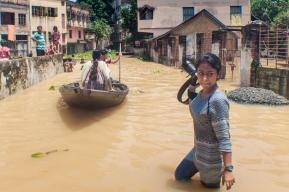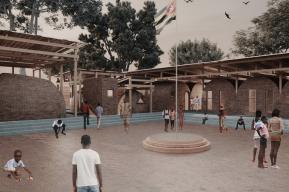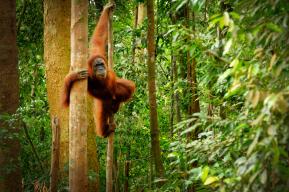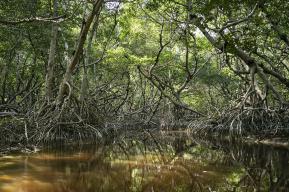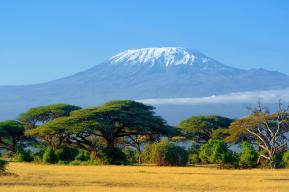文章
土著人民:保护生物多样性的知情守护者

世界上至少四分之一的土地自古以来是为土著人民所拥有、管理、使用或占用。今天,土著人民的知识日益得到认可,但是,研究人员和决策者在研究和决策过程中依然独行其是,鲜少虑及这些知识。
皮特·贝茨 (Peter Bates)
联合国教科文组织生物多样性和生态系统服务政府间科学—政策平台(IPBES)土著和地方知识技术支助股
巴硕·特拉坎苏普哈肯(Prasert Trakansuphakon)
泰国白克伦族部落可持续发展协会
在泰国北部清莱府的一片茂密森林中坐落着一个名为欣拉德奈(Hin Lad Nai)的村庄,居住在那里的克伦族村民几百年来都是实行轮作耕种。这种可持续的刀耕火种式耕作方法——曾一度被误认为是导致气候变化的一个祸因而饱受诟病——在世界各地均有使用,可使土地再生,促进生物多样性。
村民们先伐倒大树,砍除灌木,清理出小片小片的土地,再有控制地放火焚烧,积灰为肥,滋养土壤。然后,村民们在地里播种各种各样的农作物,一段时间过后,即停种休耕,让土地休养生息。最后,林木再生,繁茂如昔。如此周而复始。
块块农田,片片森林,分期耕种,次第生长,不同生境错落交织,宛若图画。在当前世界各地蜜蜂数量纷纷下降之际,欣拉德奈村却有三个野蜂种群在不断发展壮大,而且从休耕区采集的蜂蜜质量要比从森林中采集的蜂蜜更高。目前,这些蜂蜜已经销至泰国各地。
像欣拉德奈村村民这样的例子还有很多。环保主义者日益意识到土著人民在捍卫其自然遗产方面的重要作用。利用土著人民传统生态知识保护地球上日益枯竭的生物多样性意义之重大,在2019年5月发布的生物多样性和生态系统服务政府间科学—政策平台《全球评估报告》已得到明确承认。
利用传统生态知识的重要性已得到承认
联合国教科文组织长期以来一直都在支持上述举措,特别是通过主办生物多样性和生态系统服务政府间科学—政策平台土著和地方知识技术支助部的地方和土著知识系统 (LINKS)计划。
数百年的知识积累
许多土著群体生活在偏远地区,所居之地往往生物多样性高度丰富,与自然和谐共处是关乎他们生存的大计。土著人民对自身生存环境具有敏锐的观察力,他们所掌握的知识往往能让他们将各种各样的现象与生态系统变化联系起来——例如,天气模式的变化或领地内新来物种带来的影响。
以2004年海啸为例,当致命的海啸肆虐八方,位于泰国西海岸安达曼海的莫肯族村庄同样未能幸免,但素有“海上游牧民族”之称的莫肯族人却凭借数百年来积累的海啸知识,保全自身,安然无恙。
这些知识还能用于作出季节性预报和预测天气模式变化。在东非,牧民们通过观察树木的开花模式、昆虫和鸟类的行为,预测出何处将于何时发生降雨。侦察员们四处巡视,仔细观察这些生物指标,进而确定牧民们该于何时赶着牛群迁移至何处。
土著人民的知识并非一成不变,而是在不断丰富,关于对环境造成影响的新现象的知识不断融入。在加拿大北部,第一民族观察到,狼的狩猎行为和群居动态均有变化,而且北美驯鹿的数量亦随之下降,究其原因,是道路和管道将森林变得四分五裂。
动物、植物和神灵
土著知识体系包括土著人民在管理自身与生物多样性之间的关系时所遵循的价值观。在土著人民的观念中,“自然”通常包括动物、植物、地球、人类和神灵——五者之间存在互惠型亲属关系,彼此紧密相连。人类并不优于自然,自然也不是为了服务人类而存在。
土著人民认为,猎物是动物牺牲自己送给狩猎者的礼物——是应该以仪式之礼示以尊重和珍视的礼物。阿拉斯加捕鲸部落便是个中典型,那里的狩猎者会把猎物分享给其他社区成员,甚至是动物。土著人民遵循一套复杂的习俗制度、法规和禁忌体系,以此影响并约束自身与自然环境之间的关系。
然而,放眼全球,土著人民在环境和社会变化面前首当其冲。随着农业、伐木业和工业的发展,生物多样性高度丰富的地区日益受到破坏或摧毁,祖传土地经常被征用和入侵,并被改造成农场和单一种植园。这些外来干涉有时甚至还伴随着暴力。水污染日益加剧,动植物滥捕滥采现象严重,土著人可食用的动植物所剩无几,传统生计遭到破坏。
各国将土著人民融入主流社会的努力同样威胁到土著人民的生活方式。让土著学生坐在教室里跟随老师接受正规教育,会减少他们跟随长者在自然中实地学习的机会。矛盾的是,像建立保护区和禁止捕猎某些物种这类保护生物多样性的努力最终也可能会威胁到土著人民的生活方式,因为这类举措会阻碍土著人民获取食物、出入传统场所。
长者言传身教
土著社区有很多值得我们学习之处,但是,将之融入西方科学的努力却屡屡受挫,究其原因,是土著知识大多是通过口头传授或经验得来,而研究人员和决策者又倾向于查阅土著知识的书面记录,而非与土著人民当面接触。
即便如此,目前,与土著人合作进行生物多样性研究、教育、管理和决策的范例和最佳做法依然呈现出不断增加的良好势头。但通常而言,这些范例得以推进的前提是将土著人民视为平等的合作伙伴。
与土著人的合作呈现出不断增加的良好势头
与其把土著人民当成研究对象,不如让他们成为研究项目的共同设计者,参与开发对他们有意义的问题、方法和结果。在这方面,北极地区观测和知识交流(ELOKA)项目即是一个很好的范例,该项目与因纽特人合作,积极利用他们关于海冰的土著知识。
学校课程可交由土著人民自主设置并为土著人民服务,以此鼓励和促进学生在课堂之外,随长者一起在自然中实地学习。目前,加拿大第一民族社区和美国夏威夷土著社区关于这种教学方法的探索实践正不断加强。
如今,是时候让土著人民完全掌控对其土地、水域和社区的决定权,因为这样能让他们直接利用自身知识落实保护生物多样性的决定。只要能够做到这一点,对人类,对地球,对生物多样性,都将大有裨益。
拓展阅读:
《SIKU:现代科技与古老知识的融合》,联合国教科文组织《信使》,2019年1-3月
《论稻鱼鸭和人》,联合国教科文组织《信使》,2019年1-3月
《倾听湖水的声音》,联合国教科文组织《信使》,2018年4-6月
订阅联合国教科文组织《信使》,阅读发人深省的时事文章,数字版免费。
在社交网络上关注联合国教科文组织《信使》:微博、微信公众号“联合国教科文信使”、Twitter、Facebook、Instagram。
By Peter Bates and Prasert Trakansuphakon
The Karen inhabitants of the village of Hin Lad Nai, nestled in the lush forests of Chiang Rai province in northern Thailand, have practised rotational shifting cultivation for centuries. This sustainable slash-and-burn cultivation technique – once mistakenly criticized for contributing to climate change – has been used around the world to regenerate the land and support biodiversity.
Small patches of forest are cleared of trees and shrubs, before controlled burns are undertaken, to put nutrients back into the soil. A diverse range of crops is then planted for a limited period, after which the area is left fallow, or allowed to rest. Eventually, the forest grows back, and the cycle is repeated.
In this way, the community creates a mosaic of habitats in the forest, with different stages of farming and regrowth. At a time when honeybees are declining worldwide, three different species of wild bees are thriving in Hin Lad Nai. The honey harvested from fallow areas is of a higher quality than that from the forest, and is sold at markets across Thailand.
The case of the villagers of Hin Lad Nai is just one example of many. Environmentalists are becoming increasingly aware of the role that indigenous peoples play in defending their natural heritage. The importance of harnessing their traditional ecological knowledge to defend the earth’s depleting biodiversity was clearly recognized by the Global Assessment Report of the IPBES, released in May 2019.
The importance of harnessing traditional ecological knowledge has been recognized
UNESCO has long supported this initiative, particularly through the LINKS programme, which hosts the IPBES technical Support Unit on Indigenous and Local knowledge.
Centuries of knowledge
Many indigenous communities live in isolated and often highly biodiverse areas, where living in balance with nature is crucial for survival. As keen observers of their environments, indigenous peoples often possess knowledge linking various phenomena to ecosystem change – changes in weather patterns, for example, or the impacts of new species coming into their territories.
For example, centuries of knowledge about tsunami waves allowed the Moken or “sea nomads” of the Andaman Sea along the west coast of Thailand to stay safe when the deadly tsunami struck their villages in 2004.
This knowledge is also used to make seasonal forecasts and predict weather patterns. The pastoralists of East Africa are able to predict when and where the rains will fall – by observing the flowering patterns of trees, and the behaviour of insects and birds. These biological indicators are observed by scouts roaming the landscape, to determine where and when the cattle herds should move.
This indigenous knowledge is not static. It is constantly being enriched to include knowledge of new phenomena that affect the environment. The First Nations communities in northern Canada have observed changes in the hunting behaviour and pack dynamics of wolves, and consequent declines in caribou populations. These changes are attributed to the roads and pipelines that now dissect their forests.
Animals, plants and spirits
Indigenous knowledge systems include values for managing the relationship of humans with biodiversity. In their conception, “nature” often includes animals, plants, the earth, humans and spirits – all tied in reciprocal kinship relationships. Humans are not considered superior to nature, and nature does not exist to serve humans.
For some indigenous communities, animals are believed to present themselves as gifts to hunters – gifts to be respected and cherished through rituals. The meat is shared with other community members and animals, as seen notably in whaling communities in Alaska. A complex system of customary institutions, regulations and taboos serve to inform and regulate their relationships with their environments.
However, today indigenous peoples globally find themselves on the front lines of environmental and social change. Agriculture, logging and industrial development increasingly damage or destroy highly biodiverse areas, and ancestral lands are often seized or invaded and converted to farms and monocrop plantations. These interventions are sometimes accompanied by violence. Waters are increasingly polluted, and animals and plants are harvested at unsustainable rates, leaving little for indigenous communities to eat, and disrupting traditional livelihoods.
Efforts to integrate indigenous populations into national societies also threaten their way of life. Formal education with teachers in classrooms can reduce opportunities to learn on the land with elders. Paradoxically, efforts to conserve biodiversity, such as establishing protected areas or imposing bans on harvesting some species, can also prove to be a threat – as they can prevent indigenous people from accessing food and traditional spaces.
Educated by the elders
Indigenous communities have much to teach us. But efforts to integrate indigenous knowledge into western science are often unsuccessful, as it is largely oral or experiential. Researchers and decision makers tend to consult written records of indigenous knowledge, rather than engaging with the people themselves.
Even so, there are a growing number of good examples and best practices for collaborations with indigenous peoples around biodiversity research, education, management and decision-making. But these examples often hinge on indigenous peoples being considered equal partners.
There are a growing number of collaborations with indigenous peoples
Rather than subjects to be researched, indigenous communities can be supported to be designers of research projects – developing questions, methodologies and results that make sense to them. The Exchange for Local Observations and Knowledge of the Arctic (ELOKA) project, which works with the indigenous knowledge of the Inuit around sea ice, is an example of this.
School curricula can be developed by and for indigenous peoples, to encourage and facilitate learning on the land from elders, rather than only in classrooms. This approach is being increasingly explored by Canada’s First Nations communities, and the Native communities of Hawaii in the United States.
It is now time for indigenous peoples to have full control over decisions affecting their lands, water resources and communities, so that they can directly apply their knowledge to implement decisions that are biodiversity-friendly. Where this can be achieved, the benefits to people, the planet, and biodiversity will be considerable.
Peter Bates
Intergovernmental Science-Policy Platform on Biodiversity and Ecosystem Services (IPBES)
Technical Support Unit on Indigenous and Local Knowledge, UNESCO.
Prasert Trakansuphakon
Pgakenyaw Association for Sustainable Development, Thailand.




